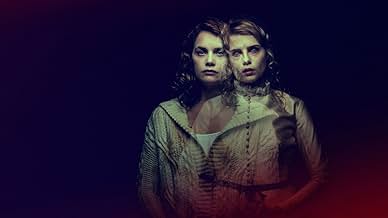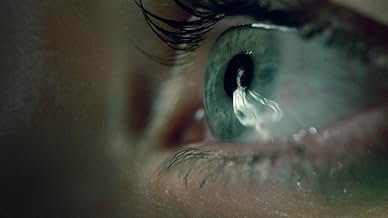अपनी भाषा में प्लॉट जोड़ेंA nervous nurse who scares easily finds herself caring for an ailing horror novelist while living in a house with hidden secrets.A nervous nurse who scares easily finds herself caring for an ailing horror novelist while living in a house with hidden secrets.A nervous nurse who scares easily finds herself caring for an ailing horror novelist while living in a house with hidden secrets.
- पुरस्कार
- 2 कुल नामांकन
फ़ीचर्ड समीक्षाएं
Consequently "Pretty" presents a ghost story within a ghost story, to put it in simplified terms. In more concrete terms the plot concerns Lily, a nurse who stays in the house of elderly horror fiction writer Iris Blum, to take care of her until her death, which shouldn't be too far into the future now. But it also wouldn't be too wrong to say that the main character is the house that had a few occupants over the course of its lifetime. I don't mean this in the tired old this-and-that-place-is-like-another-character-in-the-film way, the personality of the house certainly is made up of all the people who lived in it. But writer-director Oz Perkins takes the expression "If these walls could talk" and makes it a reality. It is about the people who lived in the house (or more correctly the people who died in it), but for all intents and purposes the main character is the house itself.
"Pretty" starts with nurse Lily's first day at the house and her opening narration tells us that she just turned 28 years old, but that she will never be 29. She talks about death, memory and says "From where I am now, I can be sure of only a very few things." One of those things is her name. So right from the beginning we know that Lily (at least Lily as a narrator) is already dead. Logic dictates that what we see on screen are her hazy memories of her short time in the house. Can we trust her words and can we trust what we see?
In any case, old Iris Blum doesn't talk much. But she keeps calling Lily by the name of Polly. And Lily seems to sense some ghostly presence in the house. Polly, as we soon learn, is the main character of Blum's most famous novel "The Lady in the Walls", a novel of which Blum said it lacks an ending because of "an obligation to be true to the subject" for Polly didn't tell Blum about her ending, but Blum tells us that she is convinced that "as endings go, Polly's was not an especially pretty one." Incidentally there also slowly emerges an ugly, moldy stain on one of the walls in the house that Lily grows concerned about. Is there some connection?
Perkins leaves the viewer in the dark for most of the film's running time about the concrete connections between all the characters, as slow and eventless as the whole thing is it is difficult to keep track of all the points of view. For example Lily isn't the only one whose voice-over we hear, we also hear and see young Blum as she writes the novel, and we hear and see Polly. Those voices also aren't particularly easy to distinguish, and it gets even more complicated when scaredy cat Lily finally dares to pick up "The Lady in the Walls" to read at least parts of it, the content of which is told from both Blum's and Polly's point of view. Through the viewer's natural desire to know the answers the film evokes ideas on the way as we contemplate all the possible answers. Did Polly really exist? Is she buried behind the wall? Are Lily and Polly somehow the same person? Is Lily a fictional character altogether? Or is Lily only imagining things?
Like a poem or a song it evokes first and foremost a tone, a mood, and sparks ideas of what it might be about. It takes further readings/listens to find that in between all the lines it actually tells a story, a simple story perhaps, but nevertheless a story. And this is actually how 'I Am the Pretty Thing That Lives in the House' worked for me. The tone and the ideas immediately took hold of me, but it took me two viewings to really make sense of the narrative. This isn't without its drawbacks, because frankly it isn't so much difficult to follow because it floods you with information that you need to sort out, on the contrary, it basically is so eventless that it poses a challenge to stay attentive for the whole time. This was, however, clearly a conscious choice by Perkins, and his approach is nothing if not consequential. But it makes criticisms of the film being "boring" particularly understandable in this case, "Pretty" indeed is very one-note, and unless it is a note you relish or that you learn to relish, it won't be enough for you to satisfyingly get you through a whole feature film.
As it turned out after two viewings, the solution to the mystery is quite concrete and surprisingly not at all convoluted. Nevertheless the ending for me is as chilling as it is simple, and it beautifully circles back onto itself, like a chorus that keeps coming back, just what you would expect a story told by a ghost to be.
It tells the story of a nurse who moves in with an old lady who was once a successful author. To say anything more would spoil it, to say anything more would also be difficult as it's rather hard to explain.
So as mentioned the visuals were great and the narration solid, sadly the visuals don't last and the narration isn't enough to save the film. Not even remotely.
The film is certainly unique but I'm not quite sure who it'll appeal to, certainly not someone seeking a horror. It's an unusual little slow burning tale that had me interested but all the while I waited for it to get going.
Alas the movie though charming fails to deliver on any front, at least for me.
The Good:
Really unique style
Great narration
Bob Balaban
The Bad:
Really dull
Goes nowhere
Things I Learnt From This Movie:
Ghosts are made by looking for them but pretending not to see
28yrs old? Hahahahahahahahahahahaha NO!
I was captured by the very first scene of the girl in the dress. Like a painting from the futurism style, it blends movement and motion into a final still, out of focus, and it looks stunning on the mostly black big screen. All of this is overlayed with narration that is simply perfectly spoken (which is consistent for the film, a beautiful read), but more importantly beautifully written. The narration, which comprises most of the spoken lines of the film, is more a poem than a movie script, and I appreciated it for it. The image was a painting, the words were literature, as a whole the film was successful as an art piece.
It revolves around a live-in nurse moving into a house to care for an old author who used to write horror books. The nurse starts experiencing subtle signs of a haunting, and finds a strange connection between what is happening to her and one of the author's most famous books.
As an idea, it was the kind of quiet horror I love, channeling fear through the uncanny, like old written weird fiction (my mind took me back to reading the Yellow Wallpaper by Gilman). Fear is not even the right word, as nothing about the film is scary, really. More like a feeling of wrongness with the world, an existential dread of sorts.
Not to detract from the beauty of the art on display, which was anything but shallow, but the plot itself unfortunately was. Pretty, but surface. Only unfinished hints of a story, that relies a bit too heavily on the viewer to fill in the gaps. I am always a fan of ambiguity, and it is almost necessary for me in a horror film (definites tend to disappoint), but there is still a balance to be struck with some concrete details. Osgood Perkins' last film, February, struck the perfect balance between ambiguity and detail, and for that was my favourite horror of 2015. Here, unfortunately, the scale has moved too much in one direction, to the point of feeling unfinished and not entirely satisfying. I also did not love the ending, which is much too close to that of another stunningly subtle recent horror, by one of the most famous current horror directors. Actually, I loved the ending (as a part of the story on display), it fit very well, I just didn't love that I had already seen it so recently. A sad problem of timing.
All in all, I can't possibly not recommend The Pretty Thing That Lives in the House, because it is a soul-satisfying kind of pretty, from sound to visuals to acting. But if what you're after is horror (or even a particularly engaging drama), it won't quench that kind of thirst. Only one for beauty.
I don't think the criticism calling it boring it fair. A lot is going on in the background if you pay attention. It reminds me of Victorian ghost stories. Not everything has to be extreme to be worth viewing.
All in all it has its problems, but worth watching if you don't mind a slow build.
क्या आपको पता है
- ट्रिवियाDirector Oz Perkins includes a few nods to his late father, actor and singer Anthony Perkins, in this film. For example, he includes the song "You Keep Coming Back Like a Song," which is performed by Anthony. Another is a clip from the film "Friendly Persuasion," which starred Anthony.
- गूफ़The narrative of the story says the young bride was brought to the house her husband built for her in 1812, but the dress and hairstyle she is wearing, as a ghost, is from the period of the 1850s to the 1860s. Since she was murdered soon after moving into the house, the dress and hairstyle do not match her backstory.
- भाव
Lily: [narrating] I have heard myself say that a house with a death in it can never again be bought or sold by the living. It can only be borrowed from the ghosts that have stayed behind. To go back and forth, letting out and gathering back in again. Worrying over the floors in confused circles. Tending to their deaths like patchy, withered gardens.
Lily: They have stayed to look back for a glimpse of the very last moments of their lives. But the memories of their own deaths are faces on the wrong side of wet windows, smeared by rain. Impossible to properly see. There is nothing that chains them to the places where their bodies have fallen. They are free to go, but still they confine themselves, held in place by their looking.
Lily: For those who have stayed, their prison is their never seeing. And left all alone, this is how they rot.
- कनेक्शनFeatured in Horror's Greatest: Hidden Gems (2025)
- साउंडट्रैकYou Keep Coming Back Like a Song
Written by Irving Berlin
Performed by Anthony Perkins and Urbie Green & His Orchestra
Courtesy of RCA Records
टॉप पसंद
- How long is I Am the Pretty Thing That Lives in the House?Alexa द्वारा संचालित
विवरण
- रिलीज़ की तारीख़
- कंट्री ऑफ़ ओरिजिन
- भाषा
- इस रूप में भी जाना जाता है
- Soy la cosa bella que vive en esta casa
- फ़िल्माने की जगहें
- उत्पादन कंपनियां
- IMDbPro पर और कंपनी क्रेडिट देखें
- चलने की अवधि1 घंटा 29 मिनट
- रंग
- ध्वनि मिश्रण
- पक्ष अनुपात
- 1.85 : 1
इस पेज में योगदान दें


























